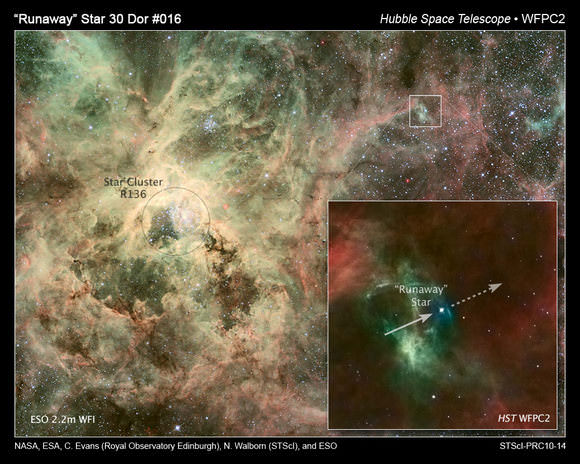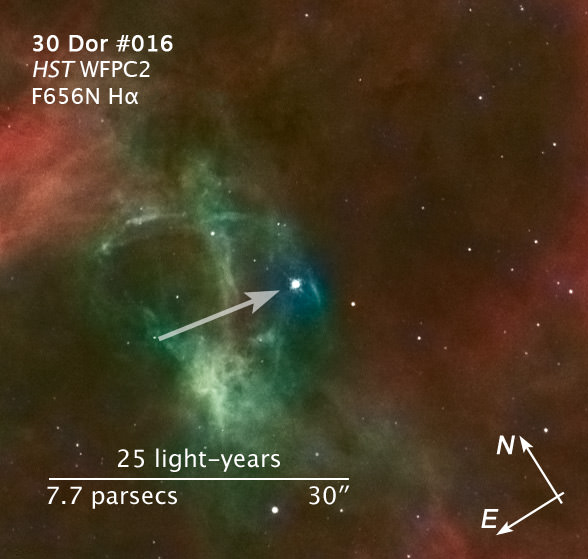[/caption]
In an astronomical version of “Biggest Loser” meets “Survivor,” a heavy weight star has been kicked out of its stellar nursery. This huge runaway star is rushing away from its birthplace at more than 402,336 kilometers per hour (250,000 miles an hour), and it likely was ejected by a group of even larger sibling stars. The future outlook for this tough-luck star seemingly doesn’t improve: Paul Crowther of the University of Sheffield, a member of the team who made the observations of 30 Dor #016, said the wayward star will continue to streak across space and will eventually end its life in a titanic supernova explosion, likely leaving behind a remnant black hole. There’s a new reality series in there somewhere!
The star on the run is found 375 light-years from its suspected home, a giant star cluster called R136 in 30 Doradus, also called the Tarantula Nebula, about roughly 170,000 light-years from Earth. R136 contains several stars topping 100 solar masses each. 30 Dor #016 is 90 times more massive than our Sun.
Astronomers say runaway stars can be made in a couple of ways: a star may encounter one or two heavier siblings in a massive, dense cluster and get booted out through a stellar game of pinball. Or, a star may get a ‘kick’ from a supernova explosion in a binary system, with the more massive star exploding first.
“It is generally accepted, however, that R136 is sufficiently young, 1 million to 2 million years old, that the cluster’s most massive stars have not yet exploded as supernovae,” says COS team member Danny Lennon of the Space Telescope Science Institute. “This implies that the star must have been ejected through dynamical interaction.”

The renegade star may not be the only runaway in the region. Two other extremely hot, massive stars have been spotted beyond the edges of 30 Doradus. Astronomers suspect that these stars, too, may have been ejected from their home. They plan to analyze the stars in detail to determine whether 30 Doradus might be unleashing a barrage of massive stellar runaways into the surrounding neighborhood.
The observations came from a team-effort using Hubble’s newly installed Cosmic Origins Spectrograph (COS) to take an image of the region in 2009, an optical image of the star taken by the Wide Field Planetary Camera 2 in 1995, and another spectroscopic study from the European Southern Observatory’s Very Large Telescope (VLT) at the Paranal Observatory. It was first observed in 2006 when a team led by Ian Howarth of University College London spotted it with the Anglo-Australian Telescope at Siding Spring Observatory.
COS’s ultraviolet spectroscopic observations showed that the wayward star is unleashing a fury of charged particles in one of the most powerful stellar winds known, a clear sign that it is extremely massive, perhaps as much as 90 times heavier than the Sun. The star, therefore, also must be very young, about 1 million to 2 million years old, because extremely massive stars live only a few million years.
The VLT observations revealed that the star’s velocity is constant and not a result of orbital motion in a binary system. Its velocity corresponds to an unusual motion relative to the star’s surroundings, evidence that it is a runaway star.
The study also confirmed that the light from the runaway is from a single massive star rather than the combined light of two lower-mass stars. In addition, the observation established that the star is about 10 times hotter than the Sun, a temperature that is consistent with a high-mass object.
“These results are of great interest because such dynamical processes in very dense, massive clusters have been predicted theoretically for some time, but this is the first direct observation of the process in such a region,” says Nolan Walborn of the Space Telescope Science Institute in Baltimore and a member of the COS team that observed the misfit star. “Less massive runaway stars from the much smaller Orion Nebula Cluster were first found over half a century ago, but this is the first potential confirmation of more recent predictions applying to the most massive young clusters.”
The research team, led by Chris Evans of the Royal Observatory Edinburgh, published the study’s results May 5 in the online edition of The Astrophysical Journal Letters.
Science paper by Evans, et al. 2010
Source: HubbleSite


Beautiful region…
I wonder if it has received a kick large enough to escape the LMC?
Nah. The ejection is more like gang warfare where all the guys gang up on one individual. Seems all the little guys ganged up on the single bully.
Angular momentum… you gotta love it!
Interesting graphic of this stellar do-si-do: http://www.spacetelescope.org/static/archives/images/screen/heic1008d.jpg